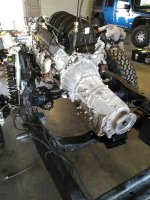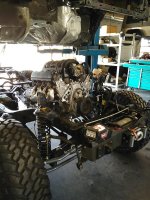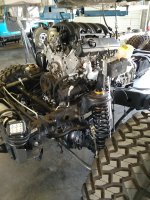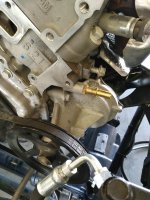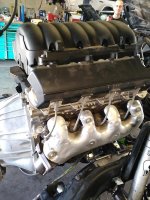The info in this tread is great! Motech if I were to look for a L83 5.3 engine, what year/make/model vehicle should I get one out of? I know it needs to be '15 or newer if I want it to pass emissions (if I were to ever move out of AZ I'd want that). Pretty much all of the engines I've looked at on Ebay are out of Chevy/GMC trucks and Chevy Tahoes. Price is MUCH cheaper than I thought it would be for a low mileage L83. The L86 is a good bit more, but the power numbers on the L83 look great. On the L83, it gets a power bump on E85 fuel of about 30 hp and tq. Would the Gen V swaps you do keep that flex fuel ability when swapped into a JK? Is the 8L80 a thing you are for sure doing? Would the 8L80 be a better trans in a heavy JK than the 6L80? I live in northern AZ (lots of steep mount climbs on the highway) and imagine the extra gears would be an advantage. The slightly lower 1st gear I imagine would be nice for crawling.
We are currently doing an L83 and L86 swap. The prices of the Gen V engines are finally starting to drop, and in the case of the 5.3 drop fast. We went through the same thing with the Gen IV engines when they were released, the yards held the prices up for a couple years until the supply was greater than demand. I'll try and get some pictures up soon.
A few interesting points with the Gen V swap:
The Gen V engines run aggressive AFM(4 cylinder mode). As with any variable displacement system when running on fewer cylinders intake vacuum drops. AFM/DOD's primary benefit is reducing pumping losses under part throttle conditions, hence less vacuum for braking. Both the LT and Pentstar engines run brake booster pressure sensors, but unlike the Pentstar's electric vacuum pump the Gen V engines run a belt driven vacuum pump. This means sufficient vacuum will be available at all times, even at low idle so you can stop 40's.
With aggressive AFM redesigned the motor mounts. When in 4 cylinder mode vibrations can be a problem. We have always run the proper hydraulic motor mounts with our conversions and now we are gearing up for the larger Gen V liquid filled mount.
The Gen V engines run electric power steering so there is no power steering pump. We are designing billet brackets for all our swaps and have purchased a VMC and Turning center so we can produce them in house. The new brackets require no alignment and will support the factory JK accessories, lines and hoses. One advantage is no custom parts to search for, they are available at your local dealer. Anyway we will support the OE PS pump as well as PSC and the other aftermarket PS pumps if you have hydraulics.
We are supporting the 8l80 transmission. The low and high gears of the 8l80 are similar to the 6l80 so I have to believe it is a move for efficiency. I'm not sold on the 8 speed transmission yet; I was disappointed with the Chrysler 8 speed I drove it never seemed happy in any gear and was always shifting. Small displacement engines and diesels like more gears to keep them in their optimal power band, but with a large V8 with lots of torque I feel the 8 speed is less useful. In a 200 mph Corvette 8 speeds make sense, in a 90 mph JK not so much. We will see after I do my testing the mpg increase may be worth it.
With the Gen IV engine I do not recommend the 5.3 for heavy JK's running in the mountains. The 5.3 is only 1.5 liters larger than the 3.8 and does not have the inherent torque to move the the weight as efficiently as the 6.0 and 6.2. The 5.3 will go into open loop(or into performance enrichment) to pull a hill where the larger engines will stay in closed loop running leaner in a higher gear. The Gen V engines may change that because with direct injection, contentious VVT and higher compression more torque will be available due to the higher cylinder pressures.
Gen IV and up engines use virtual flex fuel technology. Unlike the old days they do not run an expensive hard FF sensor. Each fuel has it's stoichiometric point, at stoich the oxygen content is about 1.5%. You breathe about 21% oxygen so primary air(air into the intake) goes from 21 to 1.5% when it exits the exhaust. Narrow band oxygen sensors can precisely determine one O2 level, and that is 1.5%. Wide-band O2's are another story. So by the OS looking at the O2 content in the exhaust it can determine the percentage of alcohol in the fuel. Stoich for pure gas is about 14.7:1 but most of us are running 10-15% alcohol so stoich for most of us is about 14.2:1. This means if you have a FF engine it will run on FF. After 2010 almost all LS's went to FF capability. FF engines, especially engines like the LC8 6.0(gas, alcohol, natural gas) run non corrosive components and hardware as well as updated heads to handle the corrosive nature of the fuel. Unfortunately North American JK's are not set up for FF and the fuel system components may be damaged if you run it. Chrysler did sell FF JK's in Europe, they have a different color fuel cap and assembly.

